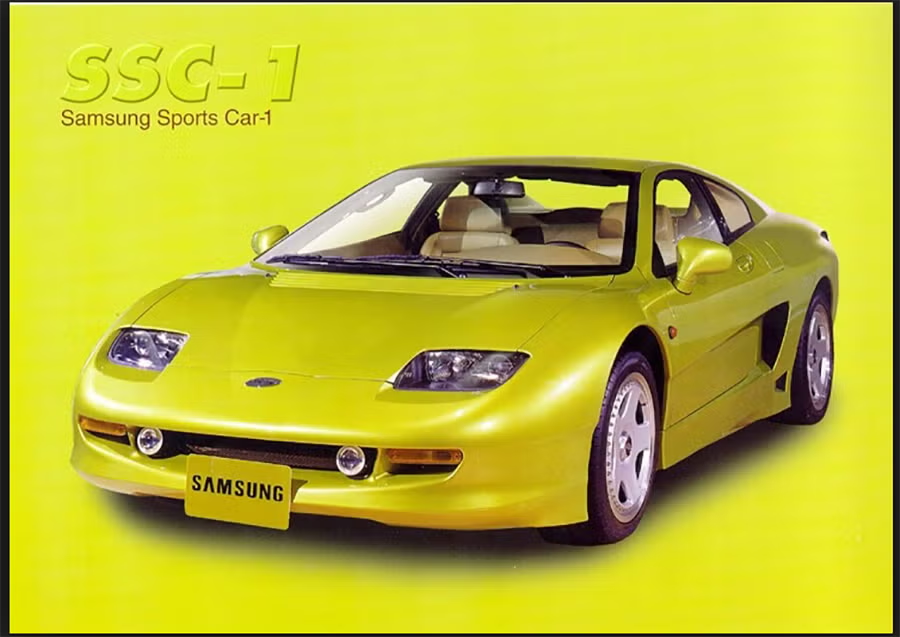
The Samsung SSC-1: Development, History, and Legacy
Samsung’s entry into the automobile industry may not be as well-known as its dominance in consumer electronics, but it is a fascinating chapter in the broader narrative of industrial development in South Korea. One of the most intriguing and lesser-known projects in this chapter is the Samsung SSC-1, an ambitious vehicle that represented Samsung’s efforts to diversify into the automotive sector in the 1990s.
This article delves into the development, history, and legacy of the Samsung SSC-1, tracing its roots, examining its place in the automotive landscape, and exploring why it ultimately failed to make a lasting impact.
Origins of Samsung’s Automotive Ambitions
Diversification in the 1990s
Samsung, primarily known for its electronics, telecommunications, and heavy industries, ventured into various sectors in the 1990s as part of a broader diversification strategy. At that time, South Korea’s chaebols (large family-owned business conglomerates) were expanding aggressively. Hyundai and Daewoo, two other major chaebols, had already established a significant presence in the automotive industry, and Samsung was keen to follow suit.
The company viewed automotive manufacturing as a way to further solidify its position as a global conglomerate. The SSC-1 project emerged from this ambition, and it was to be Samsung’s flagship vehicle in its automotive debut.
Partnership with Nissan
Rather than develop an entirely new car from scratch, Samsung sought to leverage existing technology to accelerate its entry into the automotive sector. In 1994, Samsung signed a technical partnership with Nissan, one of Japan’s leading automakers, to help facilitate this. The deal allowed Samsung to use Nissan’s technology, know-how, and platforms to produce its own cars, which would be marketed under the Samsung brand.
The first fruit of this collaboration was the Samsung SSC-1, which was based on the Nissan Cefiro (also known as the Maxima in some markets). Samsung hoped that by using a proven platform, they could reduce both the costs and risks associated with entering the competitive car market.
Development of the Samsung SSC-1
Design and Engineering
The SSC-1, developed in the mid-1990s, was largely based on the Nissan Cefiro’s design and engineering, with Samsung making some modifications to tailor the car to the South Korean market. The car was positioned as a midsize executive sedan, meant to compete with other popular models in its class such as the Hyundai Grandeur and Daewoo Leganza.
From a design standpoint, the SSC-1 featured a clean, modern aesthetic typical of mid-90s sedans. It had smooth lines, a spacious interior, and was equipped with advanced features for its time. The SSC-1 was designed to appeal to South Korean business executives and upper-middle-class consumers, aiming to present a blend of luxury and performance at an affordable price point.
Under the hood, the SSC-1 was powered by Nissan’s VQ V6 engine, a reliable and well-regarded powertrain that was known for its smooth performance. This engine was coupled with either a 4-speed automatic or 5-speed manual transmission, offering a balance between comfort and driving engagement.
Production and Release
Samsung Motors began production of the SSC-1 in 1998 at its state-of-the-art manufacturing plant in Busan, South Korea. The plant, which had been built specifically for Samsung’s automotive operations, was equipped with the latest technology and had a capacity to produce hundreds of thousands of cars per year.
The SSC-1 was officially launched in the South Korean market in the same year. Samsung hoped to sell at least 100,000 units annually and had ambitious plans for international expansion. The company had plans to export the SSC-1 to other markets in Asia and potentially to Europe, where the midsize executive sedan market was growing.
The Collapse of Samsung Motors
The Asian Financial Crisis
Unfortunately, the timing of Samsung’s automotive venture couldn’t have been worse. The late 1990s saw the onset of the Asian Financial Crisis, which severely affected South Korea’s economy. The crisis caused a sharp decline in consumer spending, and demand for cars plummeted. Even well-established automakers like Hyundai and Daewoo faced significant financial difficulties during this period, and Samsung, as a newcomer to the market, was hit even harder.
Samsung Motors, despite the quality and potential of the SSC-1, was not able to achieve the sales targets it had set. Production costs were high, and the company’s investment in its automotive division strained its financial resources at a time when its core businesses were also feeling the effects of the economic downturn.
Sale to Renault
By 2000, it became clear that Samsung Motors could not survive on its own. The company had accumulated significant debt, and the broader Samsung Group decided to exit the automotive business. In 2000, Renault, the French automobile manufacturer, acquired a majority stake in Samsung Motors for a fraction of its original investment. This acquisition marked the end of the SSC-1’s production, and Samsung’s dreams of becoming a major player in the global automotive industry were effectively over.
After the acquisition, the company was rebranded as Renault Samsung Motors, and while some of the SSC-1’s legacy lived on in subsequent models (such as the Renault Samsung SM5), the car itself became a rare and largely forgotten piece of automotive history.
Legacy and Impact
The SSC-1’s Short Life
The SSC-1 had a very short production run, and as a result, it never achieved widespread recognition or commercial success. Its existence, however, remains significant as a symbol of Samsung’s bold (if short-lived) foray into the automotive industry. The car represented the company’s ambition to diversify into new sectors, as well as the inherent risks involved in such a strategy.
Renault Samsung Motors and the SSC-1’s Influence
After Renault acquired Samsung Motors, it continued to build on the foundations laid by the SSC-1. The company’s first model, the SM5, was heavily based on the SSC-1 and the Nissan platform it used. Over time, Renault Samsung Motors established itself as a successful automaker in South Korea, producing popular models like the SM3 and SM7.
While the SSC-1 itself may not have achieved lasting fame, it played a crucial role in the establishment of Renault Samsung Motors, which remains a significant player in the South Korean automotive market today.
Collectibility and Nostalgia
Today, the Samsung SSC-1 is a rare sight, and it has garnered a small but dedicated following among car collectors and enthusiasts, particularly those interested in the history of South Korea’s automotive industry. The SSC-1 represents a unique chapter in Samsung’s corporate history, and for some, it is a symbol of the company’s willingness to innovate and take risks.
While it never achieved the commercial success that Samsung had hoped for, the SSC-1 remains an important piece of the puzzle in understanding Samsung’s broader business strategy in the 1990s.
Conclusion
The Samsung SSC-1 was an ambitious project that reflected the broader goals of the Samsung Group during a period of aggressive diversification. Though its production run was short and its impact on the global automotive market was minimal, the SSC-1 stands as a testament to Samsung’s willingness to explore new industries and expand its horizons.
Ultimately, the SSC-1 was a casualty of unfortunate timing, with the Asian Financial Crisis playing a central role in its downfall. However, its legacy lived on through Renault Samsung Motors, which built on the foundations laid by the SSC-1 to become a key player in the South Korean automotive industry.
As a rare and largely forgotten car, the SSC-1 is a fascinating piece of automotive history, offering insight into a time when Samsung’s ambitions extended far beyond electronics and consumer goods.
